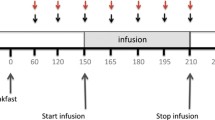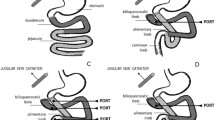Summary
The aim of the present study was to assess the role of cholecystokinin and neurotensin in converting the cyclical interdigestive pattern of pancreatic secretion into the non-cyclical fed pattern. Six healthy male volunteers were studied on 4 separate days. During each experiment a mixed liquid meal or solutions of individual nutrients were perfused intraduodenally for 180 min at 2 ml/min. The mixed meal contained 4.3 g glucose, 2.0 g fractionated soya oil, and 1.7 g casein hydrolysate per 100 ml, which delivered a caloric load of 0.9 kcal/min into the duodenum. The isocaloric and isotonic solutions of individual nutrients contained 44.5 g glucose, 17.8 g fractionated soya oil, or 44.5 g hydrolysed serum bovine albumin per liter and delivered 0.36 kcal/min into the duodenum. Duodenal aspirates and blood samples were collected at regular intervals for determination of pancreatic enzyme outputs and plasma levels of cholecystokinin and neurotensin, respectively. The mixed meal converted the cyclical interdigestive secretory pattern into the noncyclical fed pattern whereas none of the three individual nutrients abolished the interdigestive pattern. Not only the mixed meal but also lipid and protein perfusion consistently stimulated cholecystokinin release. Integrated incremental cholecystokinin release amounted to 32.3±9.9 pg/ml × 180 min with the mixed meal, 23.2±6.5 with lipid perfusion (P< 0.05 versus mixed meal) and 13.4±3.8 with protein perfusion (P<0.05 versus mixed meal). The carbohydrate solution did not significantly release cholecystokinin. None of the duodenal perfusates raised neurotensin plasma levels. We conclude that (a) intraduodenal delivery of a mixed meal at 0.9 kcal/min converts the interdigestive pattern of pancreatic secretion, (b) cholecystokinin but not neurotensin is involved in converting this pattern in response to low-caloric meals, and (c) a threshold amount of CCK release must be exceeded to convert the secretory pattern.
Similar content being viewed by others
Abbreviations
- CCK:
-
cholecystokinin
- PEG:
-
polyethylene glycol
References
Adler G, Drewe J, Steinmetz A, Liyanage K, Beglinger C (1990) Pancreatic secretory responses to long-term infusions of secretin and cerulein in humans. Pancreas 5:685–692
Adler G, Beglinger C., Braun U, Reinshagen M, Koop I, Schafmayer A, Rovati L, Arnold R (1991) Interaction of the cholinergic system and cholecystokinin in the regulation of endogenous and exogenous stimulation of pancreatic secretion in humans. Gastroenterology 100: 537–543
Beglinger C, Fried M, Whitehouse I, Jansen JBMJ, Lamers CBHW, Gyr K (1985) Pancreatic enzyme response to a liquid meal and hormonal stimulation. J Clin Invest 75:1471–1476
Ekelund K, Johansson C (1975) Output of bilirubin and pancreatic enzymes in response to different liquid test meals in man. Scand J Gastroenterol 10: 597–511
Feurle GE, Hofmann G, Carraway R, Baca I (1986) Reproduction of postprandial neurotensin plasma levels by intravenous neurotensin and the effect of neurotensin on exocrine pancreatic secretion in humans. Pancreas 1: 329–334
Fletcher DR, Blackburn AM, Adrian TE, Chadwick VS, Bloom SR (1981) Effect of neurotensin on pancreatic secretion in man. Life Sci 29:2157–2161
Go VLW, Hoffmann AF, Summerskill WHJ (1970) Pancreozymin bioassay in man based on pancreatic enzyme secretion: potency of specific amino acids and other digestive products. J Clin Invest 49:1558–1564
Hildebrand P, Beglinger C, Gyr K, Jansen JBMJ, Rovati LC, Zuercher M, Lamers CBHW, Setnikar I, Stalder GA (1990) Effects of a cholecystokinin receptor antagonist on intestinal phases of pancreatic and biliary responses in man. J Clin Invest 85:640–646
Himeno S, Tarui S, Kanayama S, Kuroshima T, Shinomura Y, Hayashi C, Tateishi K, Imagawa K, Hashimura E, Hamaoka T (1983) Plasma cholecystokinin responses after ingestion of liquid meal and intraduodenal infusion of fat, amino acids, or hydrochloric acid in man: analysis with region specific radioimmunoassay. Am J Gastroenterol 78:703–707
Hopman WPM, Jansen JBMJ, Lamers CBHW (1985) Comparative study of the effects of equal amounts of fat, protein, and starch on plasma cholecystokinin in man. Scand J Gastroenterol 20:843–847
Hummel BC (1959) A modified spectrophotometric determination of chymotrypsin, trypsin, and thrombin. Can J Biochem Physiol 37:1393–1399
Hyden S (1955) A turbidimetric method for the determination of higher polyethylene glycols in biological materials. Kungl Lantbrukshögskolans Ann 22:139–145
Liddle RA, Goldfine ID, Rosen MS, Taplitz RA, Williams JA (1985) Cholecystokinin bioactivity in human plasma. Molecular forms, responses to feeding, and relationship to gallbladder contraction. J Clin Invest 75:1144–1152
Malagelada JR, Go VLW, Summerskill WHJ (1979) Different gastric, pancreatic, and biliary responses to solid-liquid or homogenized meals. Dig Dis Sci 24:101–110
Mogard MH, Maxwell V, Sytnik B, Walsh JH (1987) Regulation of gastric acid secretion by neurotensin in man. Evidence against a hormonal role. J Clin Invest 80:1064–1067
Nustede R, Köhler H, Fölsch UR, Schafmayer A (1991) Plasma concentrations of neurotensin and CCK in patients with and without enzyme substitution. Pancreas 6:260–265
Olsen O, Schaffalitzky de Muckadell OB, Cantor P (1989) Fat and pancreatic secretion. Scand J Gastroenterol 24:74–80
Rauscher E, Neumann U, Schaich E, v. Bülow S, Wahlefeld AW (1985) Optimized conditions for determining activity concentration of alpha-amylase in serum, with 1,1-alpha-delta-4-nitrophenylmaltoheptaoside as substrate. Clin Chem 31:14–19
Read NW, McFarlane A, Kinsman RI, Bates TE, Blackhall NW, Farrar GBJ, Hall JC, Moss G, Morris AP, O'Neill B, Lee Y, Bloom SR (1984) Effect of infusion of nutrient solutions into the ileum on gastrointestinal transit and plasma levels of neurotensin and enteroglucagon. Gastroenterology 86:274–280
Schmidt WE, Creutzfeldt W, Schleser A, Roy Choudhury A, Nustede R, Hacker M, Nitsche R, Sostmann H, Rovati LC, Fölsch UR (1991) Role of CCK in regulation of pancreatobiliary functions and GI motility in humans: effect of loxiglumide. Am J Physiol 260: G197-G206
Schwarzendrube J, Niederau M, Lüthen R, Niederau C (1991) Effects of cholecystokinin-receptor blockade on pancreatic and biliary function in healthy volunteers. Gastroenterology 100:1683–1690
Spiller RC, Trotman IF, Adrian TE, Bloom SR, Misiewicz JJ, Silk BA (1988) Further characterization of the “ileal brake” reflex in man — effect of ileal infusion of partial digests of fat, protein, and starch on jejunal motility and release of neurotensin, enteroglucagon, and peptide YY. Gut 29:1042–1051
Walsh JH (1987) Gastrointestinal hormones. Neurotensin 2nd. edn. In: Johnson LR (ed) Physiology of the gastrointestinal tract. Raven Press, New York, pp 234–239
Ziegenhorn J, Neumann U, Knitsch K (1975) Determination of serum lipase. Clin Chem 25:1067–1071
Author information
Authors and Affiliations
Rights and permissions
About this article
Cite this article
Katschinski, M., Dippel, C., Reinshagen, M. et al. Induction of the fed pattern of human exocrine pancreatic secretion by nutrients: role of cholecystokinin and neurotensin. Clin Investig 70, 902–908 (1992). https://doi.org/10.1007/BF00180436
Received:
Accepted:
Issue Date:
DOI: https://doi.org/10.1007/BF00180436




